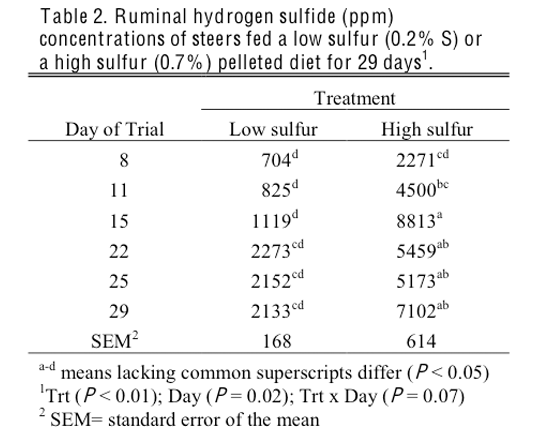



Factors Affecting Ruminal Hydrogen Sulphide Concentration In Cattle
Ruminal hydrogen sulphide concentrations may be a useful tool to determine risk of cattle developing sulphur-induced polioencephalomalacia.Summary and Implications
In this study, steers were fed a low sulphur (0.2 per cent S) or a high sulphur diet (0.7 per cent S) and ruminal hydrogen sulphide concentrations were measured. Although differences in ruminal hydrogen sulphide due to sulphur intake were maintained throughout the day, concentrations within treatment varied greatly throughout the day. Ruminal hydrogen sulphide concentrations peaked during the period from six to 10 hours after feeding. More research is needed to develop a threshold of ruminal hydrogen sulphide that may cause polioencephalomalacia. Additionally, time of sampling after feeding will need to be standardised for this risk assessment method to be successful.
Introduction
Sulphur content is one of the major limiting factors of ethanol co-product inclusion in beef feedlot diets. When large amounts of sulphur are fed to ruminants, the compound can be reduced to toxic hydrogen sulphide (H2S) by ruminal bacteria. The ruminal H2S is then eructated and subsequently inhaled by cattle, which can lead to polioencephalomalacia (PEM), commonly referred to as polio or brainers.
PEM is characterised by aimless wandering or circling, blindness, head-pressing, ataxia, muscle tremors, and, in severe cases, convulsions and death. The term PEM describes the lesions that can be observed in the brain of sick animals; unfortunately, these lesions and symptoms also can be caused by lead poisoning, water deprivation and thiamine deficiency. Therefore, diagnosing sulphur-induced PEM can be difficult and there are currently no tests available that can be performed to quantify the risk for sulphur-induced PEM, or to definitively diagnose sick animals with sulphur-induced PEM.
It has been suggested that ruminal H2S concentrations could be used as a tool to assess risk of cattle developing sulphur-induced PEM and as a diagnostic tool for veterinarians. However, little is understood about how ruminal H2S varies throughout the day and thus how time of sampling would affect potential conclusions drawn from this measurement.
Additionally, ruminally cannulated cattle provide an excellent opportunity to gather information about ruminal effects of dietary sulphur. It is, however, unclear if rumen cannulation affects H2S production and retention. Therefore, the objectives of this study were to determine the effects of dietary sulphur intake, time of sampling relative to feeding, and rumen cannulation on ruminal H2S.
Materials and Methods
Sixteen steers (8 cannulated; 781 lbs; and 8 unmodified; 849 lbs) were used in a 2×2 factorial design with the two factors being cannulation status and dietary treatment (trt). Dietary trt consisted of a low sulphur (0.2 per cent S; LS) wheat midd-based pellet or the same ingredients plus sodium sulphate to achieve a high sulphur (0.7 per cent S; HS) pellet.
Steers were blocked to pairs by cannulation status and body weight (BW) and pair-fed between trt to eliminate differences in intake among trt. During the first seven days of adaptation to the new diet, the amount of diet offered was based on initial bodyweight (BW). On day 1 of diet adaptation, steers were fed one per cent of BW and for the next six days the amount fed was increased by 0.25 per cent BW each day. Then, starting on day 8, the HS steers were fed 110 per cent of their previous day’s intake of pellets and the LS steers were pair-fed 105 per cent of their HS counterpart. All steers were fed chopped bromegrass hay at five per cent of pellet intake.
Eight steers (four pairs) at a time were housed in stalls with individual feeders and water cups. Ruminal gas was sampled from all cattle on days 8, 11, 15, 22, 27 and 29 at eight hours post-feeding. Serial H2S measures were collected from cannulated steers pre-feeding and 2, 4, 6, 10, 12, 16 and 20 hours post-feeding on day 22. Kitagawa detector tubes were used to measure H2S. Results were analyzed using PROC MIXED of SAS (SAS Inst. Inc., Cary, NC).
Results and Discussion
As designed, daily DM intake did not differ (P = 0.80) between trt (13.38 vs 13.53 lbs/hd for LS and HS, respectively). Timing of sampling relative to feeding affected (P = 0.01) ruminal H2S (Table 1). Based on these, data samples taken prior to feeding will have much lower concentrations than those taken after feeding. Hydrogen sulphide peaked around 6 to 10 hours after feeding. Hydrogen sulphide was not affected by cannulation (P = 0.35). There was a tendency for trt by day (P = 0.07) interaction for H2S measured at 8 h post-feeding (Table 2). H2S at eight hours post-feeding did not differ (P > 0.05) between dietary trts on the first day of full feed. However, H2S was greater (P < 0.05) for HS than LS on the rest of the sampling days.
The mean eight-hour post-feeding concentration of H2S for HS was 6005 ± 614 ppm and was 1639 ± 168 ppm for LS. It has been suggested by other researchers that H2S concentrations above 2000 ppm in the rumen are associated with PEM. In this study, ruminal H2S concentrations of the LS steers were at or above 2000 ppm at several time points during the day (Table 1) and HS steers were consistently above this threshold (Table 1 and 2). However, only one steer fed the HS diet developed clinical signs of PEM during this trial. This steer had H2S concentration of 12,000 ppm several days prior to the onset of PEM. The H2S concentration of this steer after the onset of clinical signs of
PEM was only 1,000 ppm, suggesting that ruminal H2S would not be a good diagnostic tool to definitively diagnose sick animals. More research is needed to develop a threshold of ruminal H2S that will induce PEM. Additionally, a standard time after feeding at which the samples are taken will need to be used in order to reduce variation in the measurement.




